I feel like we overplay keywords a lot. Now, before the SEO police come after me, let me be clear: I’m not saying keywords don’t matter.
They absolutely do, and they still play a big role in helping your site rank.
But have you ever heard the saying “overegging the pudding”?
It’s a British idiom that means spoiling something by adding too much. That’s exactly what happens with keyword stuffing.
Sure, it might have worked 20 or 25 years ago, but in 2025? Google hates it.
In this blog, we’ll break down what keyword stuffing really is and why it can hurt your site more than it helps.
Key Takeaways
- Keyword stuffing is using the same phrase multiple times throughout a webpage to manipulate search engines.
- While it may have worked when SEO was new, Google penalizes it now, so you should avoid it at all costs.
- Search engines use a variety of methods to detect keyword stuffing, so gaming the system doesn’t actually work in 2025.
- The good news is that you can prevent keyword stuffing and also fix it using simple tips and tricks.
How Google Defines and Detects Keyword Stuffing
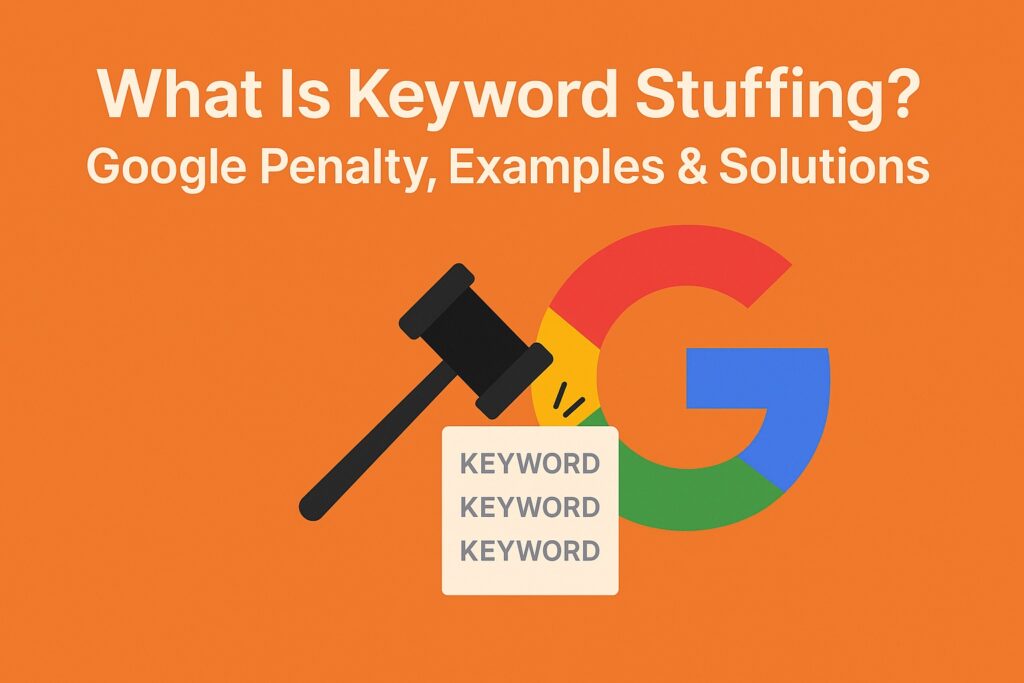
Google itself defines what is keyword stuffing pretty clearly. Here’s the definition of keyword stuffing.
Definition of Keyword Stuffing
It’s when you overload a webpage with keywords in an attempt to influence rankings.
In other words, you stop using keywords and start abusing them.
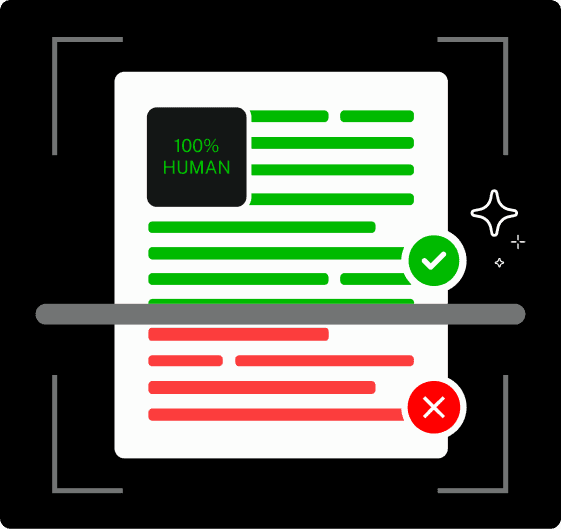
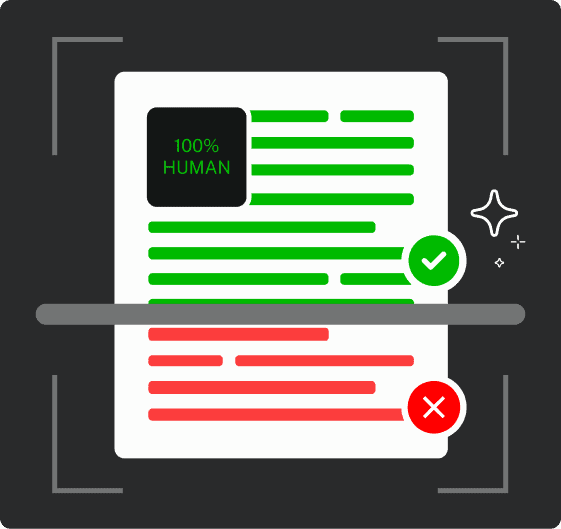
Never Worry About AI Detecting Your Texts Again. Undetectable AI Can Help You:
- Make your AI assisted writing appear human-like.
- Bypass all major AI detection tools with just one click.
- Use AI safely and confidently in school and work.
If a page reads unnaturally because the same phrase keeps appearing again and again, that’s a red flag. For example:
“If you’re looking for the best shoes online, our best shoes online store has the best shoes online for anyone who loves buying the best shoes online.”
It’s exhausting to read and screams manipulation.
Google’s algorithms are smart enough now to pick up on this kind of unnatural repetition.
Those days are long gone when algorithms just checked for the words on the page.
They now analyse context, synonyms, and how humans actually search.
If your content feels like it was written for a search engine instead of a person, Google will catch on.
It doesn’t stop at text either. Keyword stuffing can show up in meta tags, alt text, or even hidden text (yes, people still try that trick).
Google’s crawlers can see it all, and once they do, your site risks being pushed down in the rankings…or worse, flagged for spammy practices.
Early SEO Tactics vs. Modern SEO Standards
Back when SEO was new, i.e., the late ’90s and early 2000s, the game was very different.
Search engines were not as sophisticated, and websites could climb the rankings with a few simple (and often sneaky) tricks.
Keyword stuffing, hidden text, and backlink farms were the norm.
If you crammed “cheap flights” into a page fifty times, you’d most likely end up on the first page of results. It was the Wild West of search.
But times have changed. Google and other search engines are not as gullible.
The algorithms now look at user intent, content quality, and overall experience.
Updates like Panda, Penguin, and later BERT were designed to filter out low-quality, manipulative tactics and reward sites that actually serve people well.
Modern SEO does not believe in “tricking” the system. Instead, it believes in aligning with it.
This means:
- Creating content that answers questions
- Using keywords naturally where they make sense
- And making sure your site is easy to navigate and accessible on any device
It’s a shift of focus from volume to value.
Examples of Keyword Stuffing
Keyword stuffing isn’t always obvious at first glance, but once you know what to look for, it sticks out like a sore thumb.
Here are some examples of keywords you can learn from and avoid while writing your content.
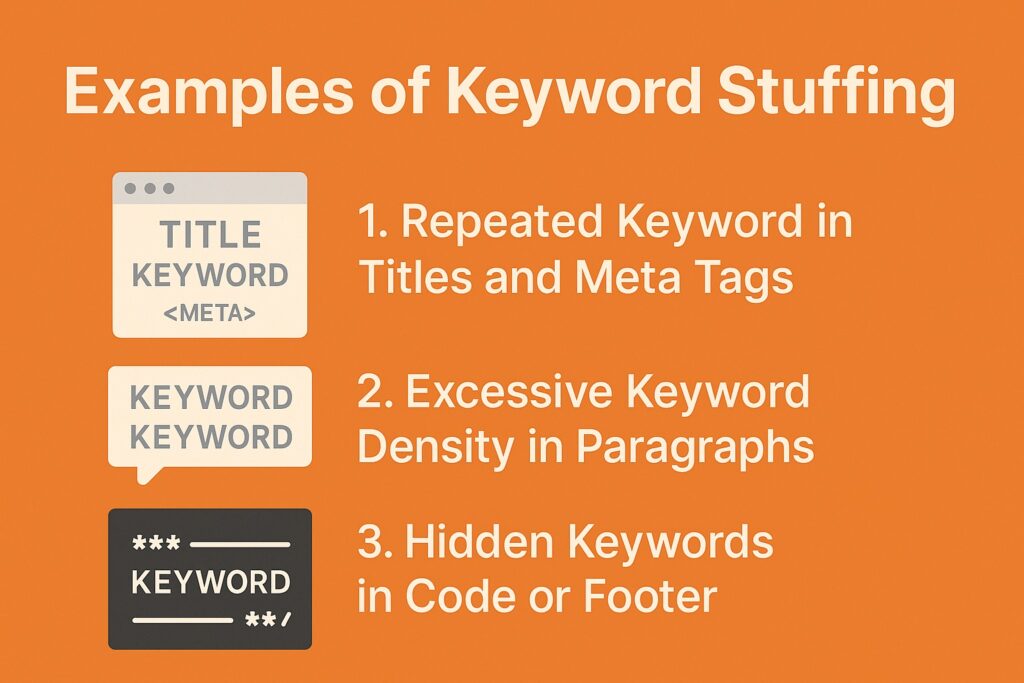
- Repeated Keywords in Titles and Meta Tags
Many people overload their websites by incorporating the same keyword over and over in their titles and meta descriptions.
Not only is it clunky, but it also makes the page look spammy to both users and search engines.
Google wants the titles and meta tags to describe what the page is about.
If yours sounds like a keyword shopping list, you are treading a risky path.
- Excessive Keyword Density in Paragraphs
This is the classic form of stuffing where the body text is overloaded with the same words until it feels robotic.
Imagine a blog post where every other sentence says “best gaming console”.
Instead of sounding natural, the content becomes unreadable, and readers will bounce before they get to the second paragraph.
- Hidden Keywords in Code or Footer
Believe it or not, some websites still hide keywords in places most visitors never see, like in the HTML code, white text on a white background, or crammed into the footer.
While these tricks may have slipped past search engines decades ago, today Google’s crawlers catch them almost instantly.
And when they do, it signals spammy intent.
If there’s anything you should learn from this pattern, it’s that SEO keyword stuffing only undermines your credibility.
How Google Detects Keyword Stuffing
Google doesn’t rely on a single trick to catch keyword stuffing.
It uses algorithms, user behaviour signals, and even manual reviews to sniff it out.
Algorithms and Natural Language Processing
BERT and RankBrain allow the search engine to “read” content precisely like a human would. It assesses how naturally words flow, whether you used any synonyms, and if the content actually answers the searcher’s question.
When text feels forced or unnatural, the system recognizes it.
User Behaviour Signals
If visitors click on your site and immediately leave because the content is unreadable or unhelpful, that sends a negative signal back to Google.
High bounce rates, low time-on-page, and poor engagement are all indicators that something’s off.
Page Elements Beyond the Text
As I already said, Google evaluates the titles, meta descriptions, and alt tags.
In most cases, it even looks at your code. If it spots the same keyword being repeated unnaturally in any of these places, that’s a red flag right there!
Manual Reviews
While most detection is automated, Google also relies on human quality raters. If raters flag your site as suspicious, it will qualify for a closer inspection by the reviewers.
Keyword Stuffing vs. SEO Optimization
You’d think keyword stuffing and SEO optimization are the same, but once you learn how much does keyword stuffing impact ranking, you’ll realize they are diametrically opposed.
One tries to game the system, while the other works with it.
Keyword Stuffing
Keyword stuffing is the ranking shortcut that backfires. It’s killing the goose that lays the golden egg.
It doesn’t help anyone since its only goal is to trick the search engines.
And while you’re busy doing that, you overlook something.
You end up having a page that reads awkwardly and gets penalized more often than it’s rewarded.
SEO Optimization
Proper SEO optimization, on the other hand, is a long-term strategy.
Keywords are still important, but they must be used in a way that feels natural and adds clarity.
Good optimization considers user intent, content structure, readability, and even design.
Google rewards this because it lines up with its ultimate mission, i.e., serving the best possible results.
So, the difference really comes down to intent.
People go for keyword stuffing when they intend to manipulate. SEO optimization is what you go with when you truly wish to serve your audience.
If you want to optimize your content without falling into the keyword stuffing trap, try Undetectable AI’s AI SEO Writer.
It can incorporate keywords naturally, so your content stays search-friendly without losing the human touch.
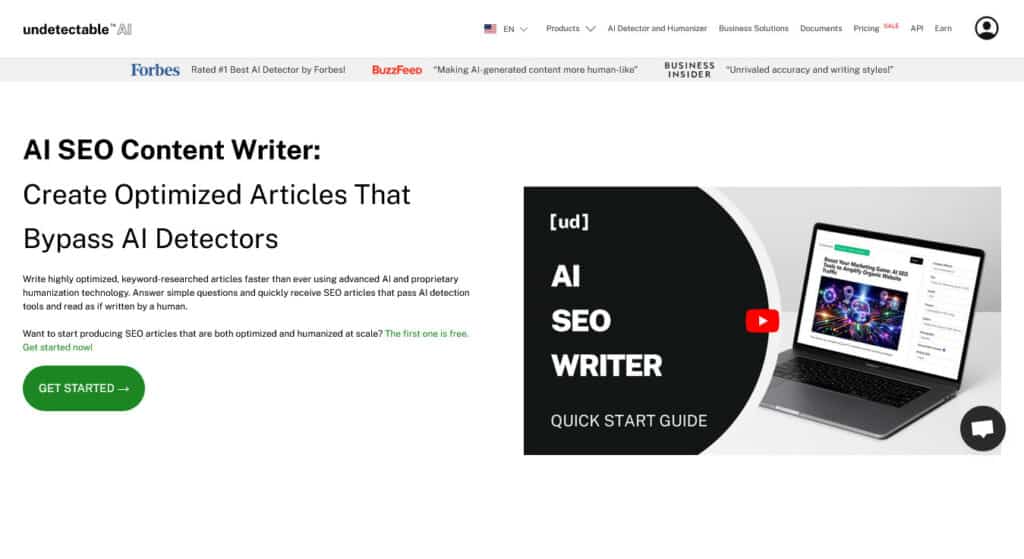
And since readability is just as important as optimization, you can also use Undetectable AI’s Grammar Checker to make sure your writing reads well.
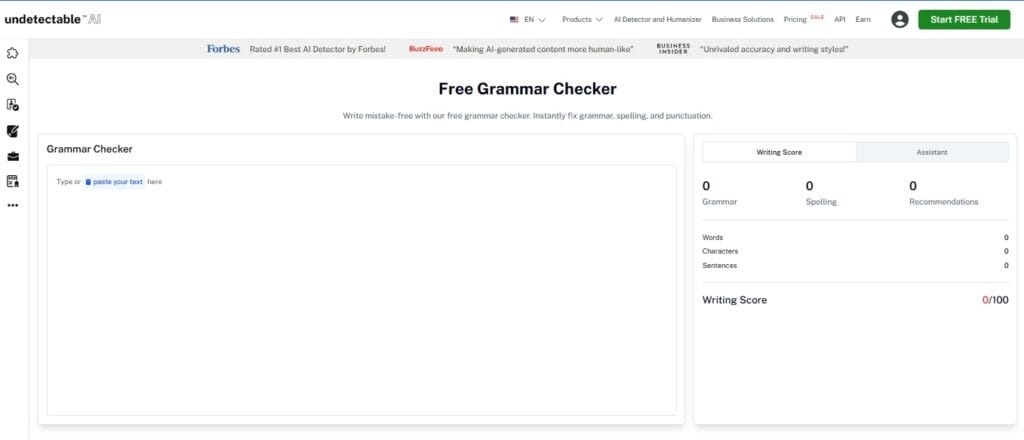
Using these two tools together gives you the best of both worlds, i.e, content that performs well on Google and keeps your readers engaged.
How to Fix Keyword Stuffing
Keyword stuffing can hurt your rankings, sure! But does it mean you can’t fix it? Certainly not!
Yes, it takes some work (or I should say rework), but it’s certainly doable. Here’s how you can do it.
Audit Keyword Density
A healthy keyword density is generally around 1–2% (that’s about once or twice per 100 words). If you’re hitting 4–5% or higher, it’s too much.
You can use tools like Surfer SEO, Semrush, or Ahrefs to scan your content and spot problem areas.
Use Synonyms or Related Phrases
You don’t have to repeat the same keyword every single time. Since Google and other search engines recognize context, you can also use variations or semantically related terms (LSI keywords).
Rephrase Awkward Sentences
When you stuff your sentences with keywords, they often end up sounding robotic.
Always read every sentence out loud so you can always spot when something feels unnatural.
Refresh Old Content
If the older blog posts or landing pages on your website are guilty of stuffing, update them.
Trim the excess, modernize the language, and add genuine value like FAQs, images, or internal links.
Use AI Humanizer by Undetectable AI
This one’s for those who use AI for content generation. AI-generated drafts often repeat keywords more than necessary.

If that happens, use Undetectable AI’s AI Humanizer to rephrase and balance the content so it reads more naturally.
Best Practices for Avoiding Keyword Stuffing
The easiest way to avoid keyword stuffing is to think less about “how many times” you’re using a keyword and more about how naturally it fits into your content.
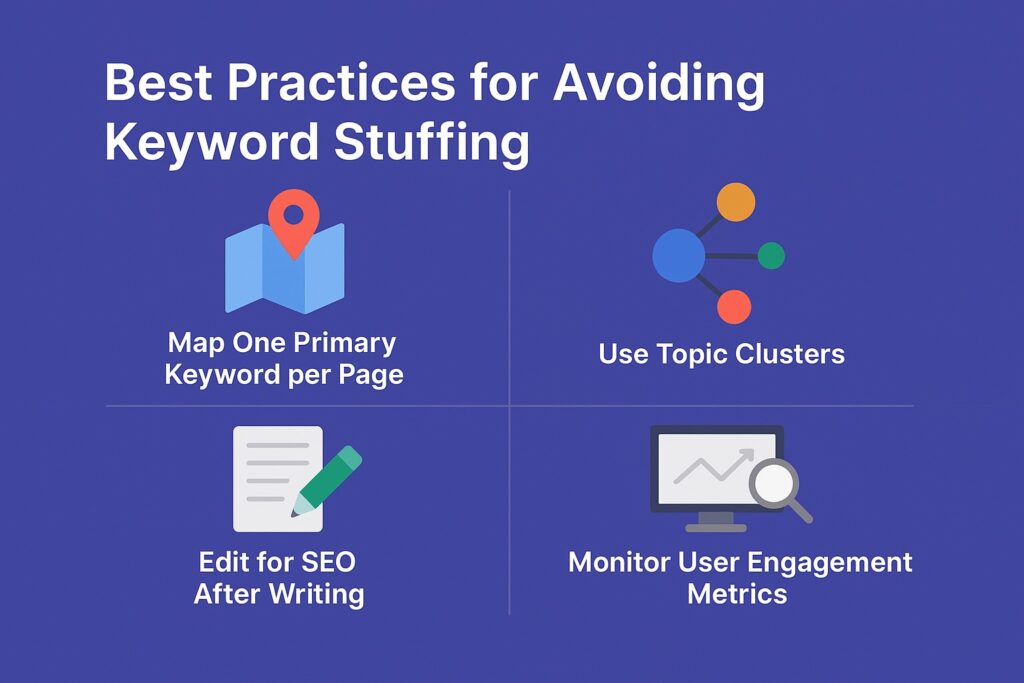
- Map One Primary Keyword per Page
Don’t try to rank a page for every related phrase. It’s better to choose one primary keyword and let secondary/related keywords support it. This also helps keep the keyword density within the range.
- Use Topic Clusters
Build supporting content around your main page or content pillar (a “pillar” page + related blog posts). This way, you don’t feel pressured to jam every keyword variation into a single page. Internal links connect the cluster and spread authority.
- Edit for SEO After Writing
Write your content without thinking about keywords. Then, during editing, make sure the target keyword appears in strategic places (title, one H2, opening 100 words, meta description).
- Monitor User Engagement Metrics
Keep an eye on your website’s bounce rate, dwell time, and CTR. A poor score in these metrics means people are leaving your page quickly, and that’s a sign it feels spammy.
Use these insights to optimize your copy for user behavior.
Detect AI-generated content and humanize it effortlessly—get started below.
Conclusion
Paracelsus, a 16th-century physician, once said, “The dose makes the poison.” He meant to say small amounts of a substance heal, but too much kills. Same with keywords.
Stop trying to cram 100 keywords in a 1000-word blog post. If you keep doing that, Google will never rank your web page at the top.
Instead, play smart. Instead of keyword stuffing, use your keywords naturally.
Tools like Undetectable AI’s SEO Writer, Grammar Checker, and AI Humanizer can help you strike the perfect balance. Trust me, that’s the only way to go!
With Undetectable AI, your content stays optimized, polished, and authentically human.
